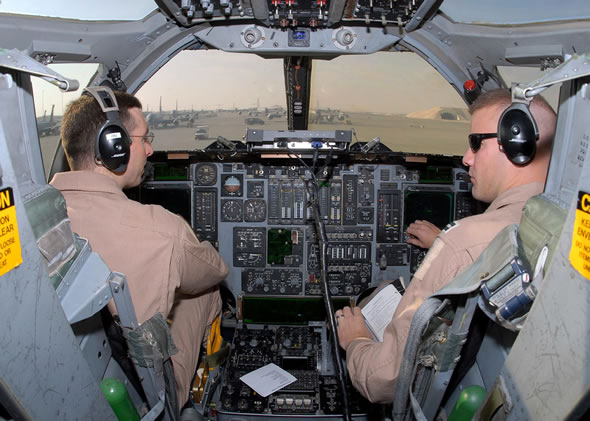
Last week Boeing was awarded two aircraft upgrading and modernization contracts, upgrading the operational capabilities of U.S. Air Force combat command F-15E Strike Eagles and B-1B Lancers.
The Air Force has granted the company to begin Low Rate Initial Production 2 (LRIP 2) of the F-15E Radar Modernization Program (RMP), replacing APG-70 radars with Raytheon APG-82(V)1 Active Electronically Scanned Array (AESA) radar systems in ten aircraft. Boeing received Milestone C authorization for six systems under LRIP 1 in September 2011. Installation of AESA radar systems is scheduled to begin in the third quarter of 2013.
The RMP is undergoing an aggressive flight test program at Eglin Air Force Base, Fla., and Nellis Air Force Base, Nev. Boeing and Raytheon are analyzing data throughout the test phase to verify that the system’s performance meets the customer’s rigorous specifications. The RMP is the latest active F-15E fleet modification that the Air Force has identified in its Modernization Sustainment Plan. Other RMP elements include a wideband radome, modified environment control system, and modified radio frequency tunable filters, which allow the radar and electronic warfare system to operate simultaneously.

The RMP APG-82(V)1 AESA radar will replace the F-15E strike fighter’s current APG-70 Mechanically Scanned Array radar, also produced by Raytheon. The AESA provides improved radar reliability, maintainability and performance, as well as reduced support costs. When integrated into the F-15E weapons system, the AESA radar will significantly improve detection and tracking of enemy targets.
Boeing has also won a separate contract worth $65.8 million Boeing to upgrade the B-1B bomber under a Lot 2 follow-on contract from the U.S. Air Force. This lot includes the delivery of Integrated Battle Station (IBS) modification kits to be installed in nine B-1 Lancer bomber. The IBS upgrade is designed to enhance situational awareness and communications for the crew. IBS integrates three major aircraft modifications, The upgrade includes a new Vertical Situation Display Unit for the forward cockpit replacing the obsolete monochrome pilot and co-pilot displays with four multi-functional color displays, giving the crew better situational awareness data in a user-friendly format. The new diagnostics system will add improved usability. The integration of the Link 16 data link will adds line-of-sight communications to the bomber’s existing beyond line-of-sight Joint Range Extension Applications Protocol (JREAP) data link. The two links will also employ new full-color displays with intuitive symbols and moving maps. “Combining the three major B-1 modifications into one installation will not only save taxpayer dollars, but also will allow us to get the bombers back to the field much faster and with more capability,” said Rick Greenwell, Boeing B-1 program director.
The initial Lot 1 contract was awarded in June 2011. Installation of those four kits will begin this fall at the company’s Maintenance, Repair, Overhaul and Technology Center in Oklahoma City. Civilian employees from Tinker Air Force Base will install the upgrades while Boeing employees provide engineering support. Lot 2 kit orders will begin immediately and the entire fleet will be upgraded by the end of 2019.
Northrop Grumman Deliver First RMIP Radar Upgrade for B-1B
Under a separate contract, Northrop Grumman recently delivered the first upgraded radar for the B-1B, the company produces these upgrade kits under a series of U.S. Air Force contracts worth a combined total of $161 million, for the B-1’s Radar Reliability and Maintainability Program (RMIP). Sofar one radar kit has since been installed on a B-1 aircraft based at Ellsworth Air Force Base, S.D. Two additional kits have been delivered to Dyess Air Force Base, Texas, and were installed in June.
“this upgrade is projected to significantly enhance B-1 mission readiness” sais Maj. Daniel P. Walters, Air Force program manager, B-1 radar. Replacing two line-replaceable units in the B-1’s AN/APQ-164 radar to RMIP will improve the radar’s reliability and maintainability. The modification kit includes a new radar receiver and transmitter, a radar processing computer and a reconfigured software package. The new hardware will provide flexibility to expand the bomber’s mission capabilities as new technologies become available. The B-1 fleet was manufactured primarily during the 1980s. “With this upgrade, the B-1 fleet will remain combat-ready for our warfighters.” said Tim Winter, vice president of Global Sensor Solutions at Northrop Grumman.
The Air Force awarded Northrop Grumman a $65 million RMIP base contract in September 2010 for 22 modification kits, with options worth an additional $95 million have since been awarded for another 38 kits. Northrop Grumman developed the RMIP upgrade prior to receiving the 2010 production contract.

















